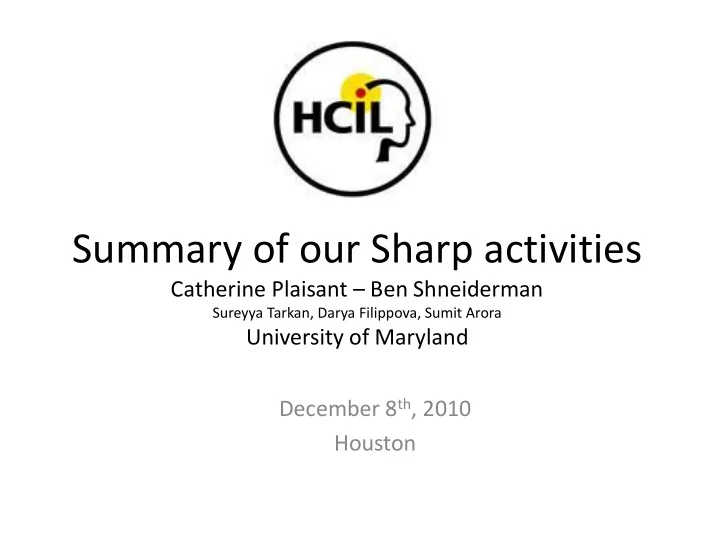

Summary of our Sharp activities Catherine Plaisant – Ben Shneiderman Sureyya Tarkan, Darya Filippova, Sumit Arora University of Maryland December 8 th , 2010 Houston
Started in September 3 topics: Medication reconciliation Lab tracking (missed labs) Medication interaction ( discussed yesterday)
What is Medication Reconciliation? December 7 th , 2010 Sumit Arora sumitar2@umd.edu
What is Medication Reconciliation? December 7 th , 2010 Sumit Arora sumitar2@umd.edu
In the Physician’s Office
In the Physician’s Office Meds listed in EHR Meds Patient says he is taking Reconciliation Updated Med List
In the Physician’s Office Microsoft Vault Meds listed in EHR Meds Patient says he is taking Reconciliation Updated Med List Interviews
In the Physician’s Office Pharmacy Other physician lists Microsoft Vault Meds listed in EHR Meds Patient says he is taking Reconciliation Updated Med List Interviews
In the Hospital – at discharge
In the Hospital – at discharge Meds reported by patient Meds given at the hospital during Intake Reconciliation Meds patient should take after going home
Steps Involved in Medication Reconciliation¹ - Verification (collection of medication history); - Clarification (ensuring that medications and doses are appropriate); - Reconciliation (documentation of changes in the orders) . ¹Getting Started Kit: Prevent Adverse Drug Events(Medication Reconciliation) www.ihi.org
1. Develop a list of current medications; 2. Develop a list of medications to be prescribed 3. Compare the medications on the two lists 4. Make clinical decisions based on the comparison 5. Communicate the new list to appropriat caregivers and to the patient http://www.ihs.gov/cio/ehr/index.cfm?module=medication_reconciliation Lots of variation between settings Data not necessarily correct/complete to start with
Current practices? • Note: your help needed • Separate lists on separate screens – See list A, See list B, enter final list on blank screen – List A and B side by side • Combined lists – No meaningful grouping (e.g. use alphabetical order) – Lots of scrolling and searching
Current practices? • Note: your help needed • Separate lists on separate screens – See list A, See list B, enter final list on blank screen – List A and B side by side • Combined lists – No meaningful grouping (e.g. use alphabetical order) – Lots of scrolling and searching
Grouped by similarity - today only exact match
Grouped by similarity - today only exact match
Next: also partial match
Next: also partial match
Actions to reconcile: Actions in reconciled list [Continue] [Stop] [Modify]? [Add new med]?
BETTER WAYS OF GROUPING MEDS ?
BETTER WAYS OF GROUPING MEDS ?
Missed Test Results Sureyya Tarkan HCIL sureyya@cs.umd.edu March 15, 2011
What are Missed Results? Mishandling of abnormal test results (Wahls, 2007) No follow-up Physicians order many tests (29-38%) (Elder, 2009) Sent to outside facilities (laboratories, hospitals, etc.) The complexity of the process, separation of lab from clinic location and lack of quality control systems in outpatient setting make testing error-prone (Hickner et. al., 2007).
Test Processing Steps (McEwen; Hickner, 2005-8) Pre-analytic 1 Specify the test Ordering the test • & when to do it Implementing the test • Analytic 2 Lab technicians Performing the test • Post-analytic 3 Reporting results to the clinician • Review results Responding to the results • & Decide what to do Notifying the patient of the results • Following-up to ensure the patient took the appropriate • action based on test results
Existing System: Partners Healthcare Results Manager
Order Tracking Prototype (and simulation) March 15, 2011
Order Tracking Prototype (and simulation) March 15, 2011
Tracking March 15, 2011
Tracking March 15, 2011
Testflow Process
Tracking March 15, 2011
Tracking March 15, 2011
Tracking March 15, 2011
Actions combined with Review of Results
Darya Filippova Nov 2010 HCIL
Doctors prescribing meds Pharmacists filling the prescriptions Self-monitoring (MS Health Vault, Google Health)
2006 study in Dutch pharmacies: 153 days, 43K prescriptions, 2.5K alerts (6%). 72.3% alerts – recurrent, no action was taken Buurma et. al, Clinical Risk Management in Dutch Community Pharmacies. Drug Safety. 29 (8): 723-732. 2006
2007 study in Switzerland pharmacies 600 patients taking 2+ drugs Most pharmacies: “severe” and “moderate” alerts only 79% of all DDI alerts – overridden Indermitte et. al, Management of drug-interaction alerts in community pharmacies. J. C. P. and T. 32: 1323-142. 2007
Incorrect alert (clinical data) Acceptable interaction Irrelevant (meds not taken) Multiple alerting Patient tolerated drugs before
Decrease number of alerts Resolving alerts Patient User/physician Record DDI resolution Immediate OR significant harm
Should we allow “enabling” resolved alerts? How do we elevate alert’s importance? Patients with similar profiles What is similar?
Thank You plaisant@cs.umd.edu ben@cs.umd.edu
Recommend
More recommend